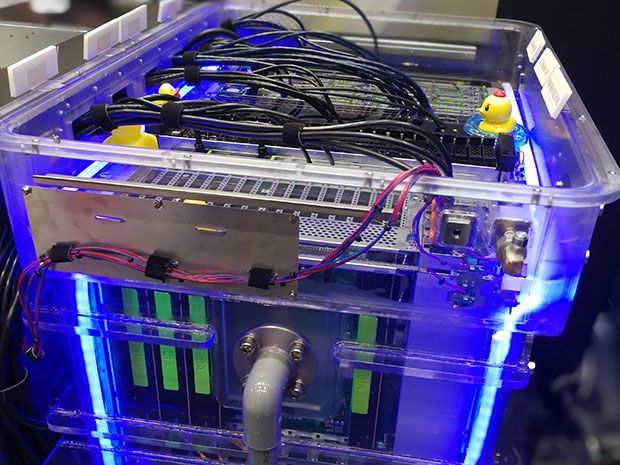![]()
Given the prodigious heat generated by the trillions of transistors switching on and off 24 hours a day in data centers, air conditioning has become a major operating expense. Consequently, engineers have come up with several imaginative ways to ameliorate such costs, which can amount to a third or more of data center operations.
One favored method is to set up hot and cold aisles of moving air through a center to achieve maximum cooling efficiency. Meanwhile, Facebook has chosen to set up a data center in Lulea, northern Sweden on the fringe of the Arctic Circle to take advantage of the natural cold conditions there; and Microsoft engineers have seriously proposed putting server farms under water.
Fujitsu, on the other hand, is preparing to launch a less exotic solution: a liquid immersion cooling system it says will usher in a “next generation of ultra-dense data centers.”
Though not the first company to come up with the idea, the Japanese computer giant says it’s used its long experience in the field to come up with a design that accommodates both easy maintenance and standard servers. Maintenance is as straightforward to perform as on air-cooled systems, for it does not require gloves, protective clothing or special training, while cables are readily accessible.
Given that liquids are denser than air, Fujitsu says that immersing servers in its new system’s bath of inert fluid greatly improves the cooling process and eliminates the need for server fans. This, in turn, results in a cooling system consuming 40 percent less power compared to that of data centers relying on traditional air-cooling technology. An added bonus is the fanless operation is virtually silent.
“It also reduces the floor space needed by 50 percent,” says Ippei Takami, chief designer in Fujitsu’s Design Strategy Division in Kawasaki near Tokyo. Takami showed off a demonstration system at the company’s annual technology forum held in Tokyo this week.
A cooling bath measures 90cm x 72cm x 81cm WDH, while the rack it fits into measures 110cm x 78cm x 175cm WDH. The coolant used is an electrically insulating fluorocarbon fluid manufactured by 3M called Fluornert.
A bath has a horizontal 16-rack unit space. Two baths in their racks can be stacked vertically one on top of the other, and dedicated racks holding eight baths in two rows of four are available.
“There is no limitation on the number of stacks that can be used,” says Takami. He also points out that a bath’s dimensions are compatible with regular 48-centimeter rack-width specifications. So any air-cooled rack-mountable servers can be used as long as they meet the depth requirements of the bath and when unnecessary devices like fans are removed.
The scheme employs a closed bath, single-phase system in which the servers are directly submerged in the dialectic fluid. A lid is used to cover the bath to prevent evaporation.
A coolant distribution unit (CDU) incorporates a pump, a heat exchanger, and a monitoring module. The fluid captures the heat generated by the servers’ HHDs, SSDs or other devices, and transfers it via the CDU to the heat exchanger where it is expelled outside the data center by means of a water loop and cooling tower or chilling unit. The fluid is then pumped back into the bath after filtering. The monitoring system warns maintenance engineers of any abnormal conditions via a network.
Takami says because the fluid protects the servers, the system can be deployed anywhere, no matter how harsh the conditions or environment may be.
No word on a price tag yet, but Takami reveals some companies are already evaluating the system. Fujitsu expects to ship the product later this year.

